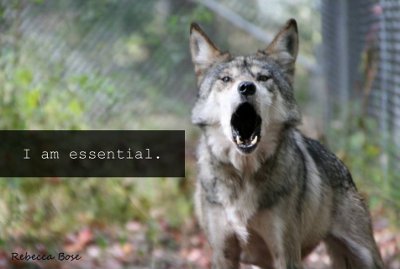In the News: Wolf Supporters, Foes Debate Issue

You can help ensure the future of the lobo by submitting comments to the Fish and Wildlife Service, and by writing a letter to the editor of the White Mountain Independent.
One letter from you can reach thousands of people and will also likely be read by decision-makers. Tips and talking points are below, but please write in your own words, from your own experience. Don’t try to include all the talking points in your letter.
Talking points
- While giving Mexican wolves their own Endangered Species Act listing is long overdue, delisting gray wolves throughout the U.S. is counter to protecting Mexican wolves. The proposed rule will leave gray wolves unprotected in places that scientists have said are needed for Mexican wolf recovery, making it more difficult to protect Mexican gray wolves even if they are allowed to expand into new areas.
- The USFWS should move forward with allowing new wolves to be released throughout the Blue Range Wolf Recovery Area. The Mexican gray wolf is the most endangered mammal in the U.S. with only about 75 in the wild. Additional wolves must be released into the wild now to increase the genetic health of the species. Numerous wolves are in captive breeding facilities around the country, prepared for, and awaiting, release.
- Wolves once lived throughout the west and played a critical role in keeping the balance of nature in place. We need to restore this important animal that has been missing for too long.
- Wolves need freedom from boundaries. Given room to roam, the wolves will establish themselves in suitable areas with adequate game. The USFWS proposal does not allow wolves to establish new packs and populations in additional areas that are essential to their recovery.
- Additional populations of Mexican wolves are necessary to their recovery and genetic health, as is the ability for wolves to move between populations.
- Capturing and moving wolves is always a risky business that can result in death or trauma to the wolf.
- The USFWS should designate Mexican gray wolves as essential. By labeling all of the wild wolves as “nonessential” the USFWS ignores science and the reality of 15 years of experience with reintroducing wolves.The 75 wolves in the wild have up to four generations of experience in establishing packs and raising pups and are over 22% of all of the Mexican wolves in the world.
- The USFWS needs to quit stalling and complete a comprehensive recovery plan at the same time as or before changing the current rule.
- The likelihood of a person being hurt by a wolf is almost non-existent. In rural areas, people are far more likely to be harmed by things accepted as part of daily life, such as domestic dogs, livestock, or off-road vehicles. Mexican wolves are small, weighing 50-85 pounds, and tend to avoid people.
Make sure you:
- Thank the paper for publishing this article.
- Include something about who you are and why you care: E.g. “I am mother, outdoors person, teacher, business owner, scientific, religious, etc.)
- Provide your name, phone number and address. The paper won’t publish these, but they want to know you are who you say you are.
- Submit your letter to the Editor of the White Mountain Independent here.
__________________________________________________________________________________________________________________________
Click here to join our email list for Mexican gray wolf updates and action alerts.
Visit us on Facebook here.



